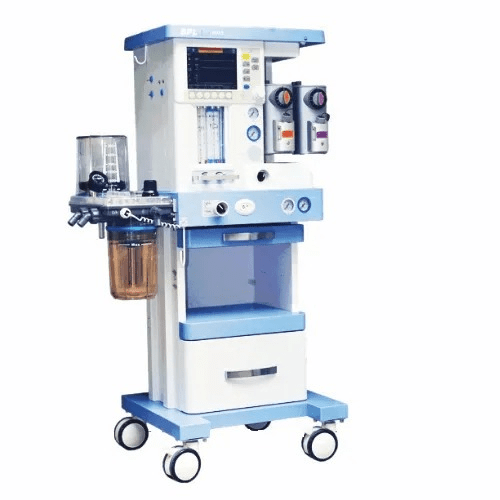PORTABLE ANAESTHESIA MACHINE:
An anesthesia machine is the apparatus used to deliver general anesthesia to patients as they undergo a medical procedure. The most commonly used device is the continuous-flow anesthetic machine, which provides a steady flow of air containing a regulated supply of gas.
It is a user friendly anesthesia delivery system that helps you deliver attentive care to the patient during surgical operation.
Anesthesia Machine is a vital medical device designed for the safe and controlled delivery of anesthetic gases to patients during surgical procedures.
The gases pass through a vaporizer where anaesthetic is added to the fresh gas flow. This mixture is delivered, via the common gas outlet, to a patient breathing circuit, usually a ‘circle system’. This circulates gases and vapours and contains a carbon dioxide absorber to stop patients re-breathing carbon dioxide.
The basic function of an anaesthesia machine is to prepare a gas mixture of precisely known, but variable composition. The gas mixture can then be delivered to a breathing system.
The modern anesthesia workstation is an integrated unit consisting of the following components: Basic components of anesthesia machine unit (including gas delivery, electronic flowmeters, vapourizers, breathing circuit, scavenging system) Advanced Ventilation. Anesthesia and patient monitoring system.
THE SAFETY FEATURES IN AN ANAESTHESIA MACHINE:
- Gas supplies: From the central pipeline to the machine as well as cylinders.
- Flow meters.
- Vaporizers.
- Fresh gas delivery: Breathing systems and ventilators.
- Scavenging.
- Monitoring.
The main components of an anaesthetic machine:
- Gas Flow Through the Anesthesia Machine.
- Important Components of the Anesthesia Machine.
- Vaporizer.
- Adjustable Pressure Limiting Valve (APL Valve)
- Oxygen Flush Button.
- Carbon Dioxide Absorbent.
- Types of Anesthesia Circuits.



Reviews
There are no reviews yet.